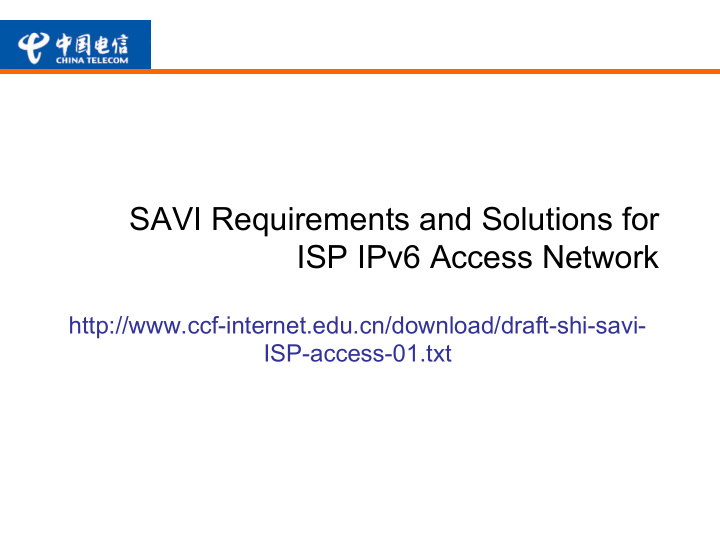



SAVI Requirements and Solutions for ISP IPv6 Access Network http://www.ccf-internet.edu.cn/download/draft-shi-savi- ISP-access-01.txt
Abstract The Source Address Validation Improvement (SAVI) was developed � to prevent IP source address spoofing which can enable impersonation and malicious traffic redirection. An Internet Service Provider (ISP) who provides Internet access services, information services and value-added services to the customers should guarantee security of its network and customers' privacy. Thus, the mechanism is essential for ISPs. However, due to a diversity of ISPs' access network, SAVI solution � is also different accordingly. This document describes five scenarios of ISPs' IPv6 access network, moreover, states its SAVI requirements and according tentative solutions. These scenarios will cover the most of the Internet access scenes in China Telecom. And maybe the reference to other ISPs.
Current Network Situation Spoofing issue becomes more � critical IPv4 exhaustion � Spoofable netblocks, IP addresses and AS From MIT spoofer project Transition is a long period � SAVI only works in IPv6 � Ethernet subnet with DHPC now. IPv4 Address Resources From http://www.potaroo.net/tools/ipv4/
Scenario 1: Home gateway act as DHCPv6 proxy General Scene Workflow 1. HG get a link-local IPv6 address from BRAS via PPPOE and ND RA. It is the WAN IP address of the HG. 2. HG get IPv6 prefix from BRAS via DHCPv6-PD. It is the Prefix for the ones access to the HG, here are PC and STB. BRAS 3. PC or STB device get IPv6 prefix via DHCPv6-PD. Note: Of course PC and STB can also get IPv6 address via 2 1 ND/RA, but the DHCPv6 is much popular. ND SAVI Solution: 1. Deploy SAVI device to position of near HG DHCPv6 3 2. SAVI mechanism needs to improve to snoop the procedure of DHCPv6-PD so as to bind the DHCPv6 relationship <HG/PC/STB's address, port, MAC>.---It’s new one? Note: BRAS: Broadband Remote Access Server PPP HG: Home Gateway. Here HG is L3 router. DHCP STB: Set Top-box
Scenario 2: STB gets IP address via DHCPv6 General Scene Workflow STB which has internal account and password gets IPv6 prefix by DHCPv6. 1. STB send request to all routers on local link by DHCP using link-local address based on its MAC address. Server AAA 2. The BRAS informs STB to adopt DHCPv6 address assignment method as a response. BRAS 3. STB initiate DHCPv6 procedure and BRAS act as a DHCP Relay to add some authorities' messages. 4. AAA server decides whether assign address 1 2 parameters according to the result of authentication. BRAS receives IPv6 parameters from AAA server, DHCPv6 and then, informs STB by DHCPv6. Note: There also maybe HG between STB and BRAS, but used as L2 bridge only. SAVI Solution: 1. Deploy SAVI device to position of near STB DHCP 2. It just needs to bind relationship <STB's IP Address, port, STB's MAC Address> which is included in existing function.
Scenario 3: PC gets IP address via PPPoE & RA General Scene Workflow AAA 1. PC get link-local address via PPPoE. 2. BRAS broadcast IP prefix via RA BRAS 3. PC automatically configuration SAVI Solution: ND 1. Deploy SAVI device to position of near PC 2. It is also need to improve its mechanism in order to enable PPPoE snooping like scenario 1 and binding relationship <PC's IP Address, port, PC's MAC> PPP
Scenario 4: Laptop accesses Internet via WLAN DHCP General Scene Workflow Server 1. Laptop get IPv6 address via DHCPv6. AAA 2. Users were enforced to be certified by BRAS submitting password on a portal page. DHCPv6 SAVI Solution: 1. Deploy SAVI switch to position of near laptop. 2. It just needs to bind relationship <LAPTOP's Laptop IP Address, port, LAPTOP's MAC> which is included in existing function. DHCP
Scenario 5: Laptop accesses Internet via C+W General Scene Workflow 1. Laptop get a temporary IPv6 address from BRAS via DHCPv6. 2. Laptop obtains the WAG address from DNS server. The laptop PDSN establishes a UDP tunnel to WAG by sending register request. AAA 3. If the tunnel established successfully, the laptop can get IPv6 prefix from PDSN via PPP and RA, whereas PDSN acts as the WAG AN-AAA PPP terminal. 4. At last, the laptop gets some additional information such as DNS address. When the above steps all accomplished, the laptop BRAS acquires the ability to access Internet. N D SAVI Solution: DHCPv 1. Deploy SAVI switch to position of near PC 6 2. It is also need to improve its mechanism in order to enable PPPoE snooping like scenario 1 and binding relationship Lapto <Laptop's IP Address, port, Laptop's MAC>. p Note: PPP WAG: Wireless Access Gateway DHCP PDSN: Packet Data Serving Node AN-AAA: Access Network Authentication, Authorization and Accounting Server
Conclusion � There are various scenarios of ISPs'IPv6 Access Network. Because each scenario uses different address assignment method and protocol, there are a variety of requirements to validate source address for ISPs' IPv6 access network. � SAVI cannot support all protocols and methods right now, but, due to expansibility of SAVI, the mechanism can satisfy these various demands with a little improvement. � This document presents five typical scenarios of ISPs'IPv6 access network, and proposes tentative SAVI solutions including some improvement.
End Authors' Addresses Fan Shi China Telecom Email: shifan@ctbri.com.cn Ke Xu Tsinghua University Email: xuke@mail.tsinghua.edu.cn Thanks! Liang Zhu Tsinghua University Email: tshbruce@gmail.com Guangwu Hu Tsinghua University Email: hgw09@mails.tsinghua.edu.cn
Recommend
More recommend